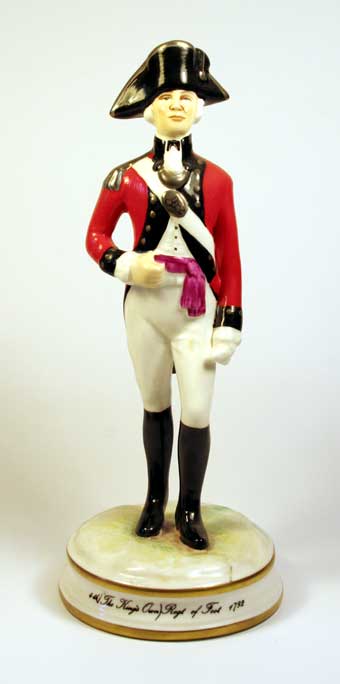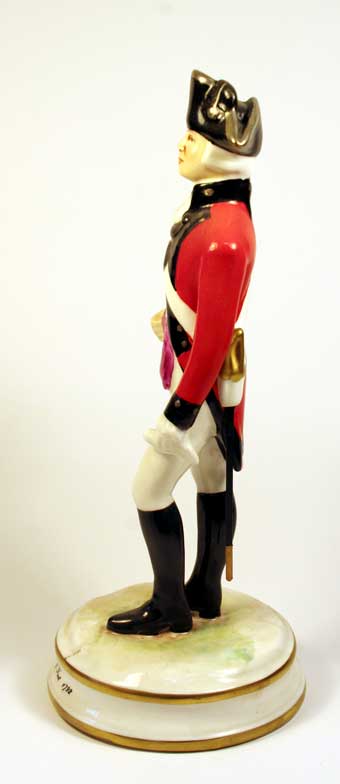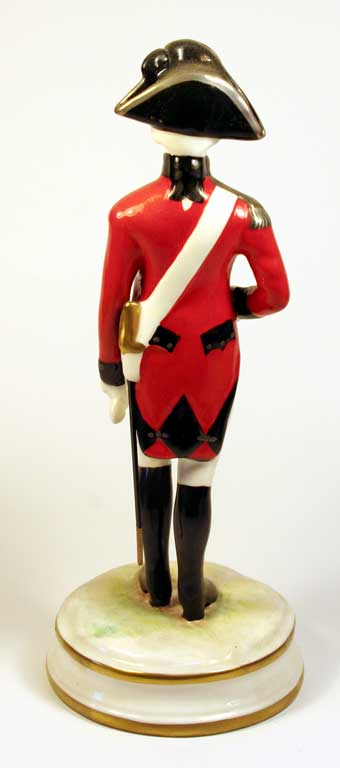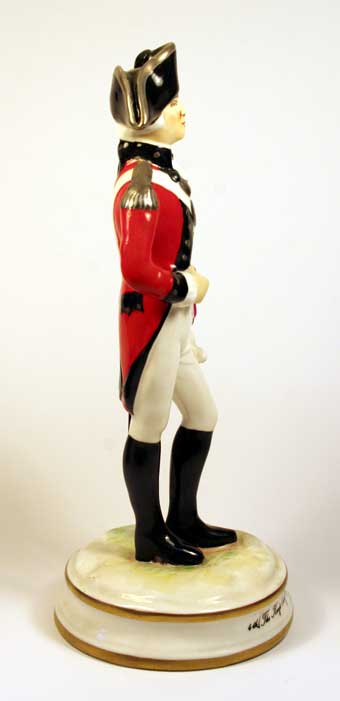Collections - Regimental Treasure
Porcelain Figure, Officer of the King's Own, 1792.




Porcelain figure, King's Own Royal Regiment, 1792 uniform, made to
commemorate the Tercentenary of the King’s Own Royal Regiment, 1980,
Limited Edition, number 144 of 250. Made by Michael
Sutty.
Accession Number: KO1291/01
Michael Sutty:
By teaching himself the almost forgotten and abandoned skills required
for the production of figures in fine bone china, Michael Sutty became
the leading sculptor of uniformed military figures of his time. He read
voraciously, and although an autodidact he became prodigiously
well-informed not only about sculpture and ceramics, but about art and
the history of art, history and military history.
He created figures in clay so complex and technically difficult that the
established china manufacturers at Stoke-on-Trent described them as “un-makeable”,
and this led him to set up his own production there. His figures
demonstrated a technical virtuosity which the manufacturers lacked, and
had a beauty which they could only admire: nevertheless, he did not
endear himself to the ceramics establishment.
Perhaps as a result he never achieved a balance between the expression
of his artistic ambitions, and commercial equilibrium. Over thirty years
he was to suffer more than one failure, and this somewhat clipped his
wings.
Born in 1937, he was educated at Douai, where he was confirmed in the
faith to which he returned in later years, and where he absorbed the
Benedictine ethic that was to remain with him throughout his life. He
resisted attempts to train him to play a role in his father’s
engineering business, and after his two years’ army service he bought on
a whim a packet of modelling clay. With this in his hand he knew he had
found his metier. Seeing a gap in the market for uniformed military
figures, for ten years he worked alone producing handmade pieces.
As a young man he was rather a charismatic figure to his peers, and when
he found that life in the Army could be a dulling struggle he sought to
introduce elements of colour, dash and flair. He admired the qualities
of courage and loyalty, and the devotion to the imperial ideal shown by
the men he sculpted, and he was inspired by a patriotism by now out of
fashion.
His view of these qualities was not so partisan as to exclude Napoleon
and the handful of his marshals of whom he made portrait busts. They
were not called portraits idly: they were drawn from the finest
documentary evidence and were identifiable at twenty paces — as were his
Wellington, and Nelson with his companions Hardy and Collingwood.
Sutty’s research was invariably immaculate. He knew it must bear the
critical scrutiny of regimental historians and museum curators, and so
it did.
He retained always a loyalty to the material which had from the
beginning seized his interest. Bone china is intractable, difficult and
costly to work, but when fired it acquires a life which for him set it
apart.
The Falklands campaign inspired more than one piece: that of the Marines
in the Raising of the Flag at San Carlos Bay was acquired by Margaret
Thatcher, of whom he was a great admirer. She described his figures as
“works of genius”, and remained a loyal friend and advocate of his work.
His Heroic Action series, which encompassed several of his most complex,
imaginative and flamboyant works, dealt with famous acts of personal
bravery, at Balaclava, Waterloo and elsewhere. Many of them included
mounted figures, and as an equine sculptor Sutty was virtually without
peer.
During the 1990s, seeking to produce work attractive to a wider public,
he created figures inspired by the images of Sir William Russell Flint.
He understood the watercolourist’s work so well that the figures were at
once recognisable as Russell Flints, though Sutty perhaps chafed a
little at the limitations of faithfully transposing another artist’s
work into a new medium.
The innate modesty of his manner concealed both an intellect of quite
unusual refinement and scope, and the firmness of his convictions. His
finely tuned sensitivity to the concerns and feelings of others
manifested itself in unfailing good manners and grace under pressure.
Eve Clark, his partner of 29 years, had a vital role as the public face
of the business, but never managed quite to tame the artist in him so as
to command commercial success. During his last few months, his wish to
marry her was fulfilled.
Michael Sutty, porcelain sculptor, was born on June 24, 1937. He died on
November 5, 2003, aged 66.
© Images are copyright, Trustees of the King's Own Royal Regiment Museum.
You must seek permission prior to
publication of any of our images.
Only a proportion of our collections
are on display at anyone time. Certain items are on loan for display
in other institutions. An appointment is required to consult any of
our collections which are held in store.





